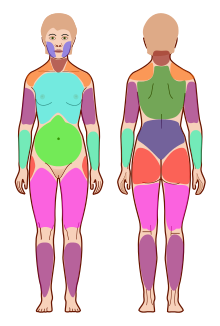Widespread Pain Index
The Fibromyalgia Widespread Pain Index or WPI is a patient rating that assesses how much of the body regularly causes pain. It was introduced by the American College of Rheumatology in the 2010 diagnostic criteria for fibromyalgia.[1]
WPI and Tender points[edit | edit source]
The Widespread Pain Index replaces the older tender point scoring and does not rely on a trained clinician pressing on painful areas.
WPI scoring[edit | edit source]
The WPI score is between 0 and 19. Each of the 19 tender point areas in the soring diagram is given a score of 1 (pain present at least weekly), or 0 (no pain or pain present less often).[1][2]
- Left shoulder girdle
- Right shoulder girdle
- Left hip (buttock, trochanter)
- Right hip (buttock, trochanter)
- Left jaw
- Right jaw
- Left upper arm
- Right upper arm
- Left upper leg
- Right upper leg
- Left lower arm
- Right lower arm
- Left lower leg
- Right lower leg
- Upper back
- Lower back
- Chest
- Neck
- Abdomen
The WPI is the total number of areas that are painful, giving a maximum value of 19. Pain severity is not scored in the WPI.[1]
After WPI value is calculated, the Fibromyalgia Symptom Severity (SS) is worked out, and the two scores together area used to determine if someone has fibromyalgia.
References[edit | edit source]
- ↑ 1.0 1.1 1.2 1.3 Wolfe, Frederick; Clauw, Daniel; Fitzcharles, Mary-Ann; Goldenberg, Don; Katz, Robert; Mease, Philip; Russel, Anthony; Russel, I. Jon; Winfield, John; Yunus, Muhammad (May 2010). "American College of Rheumatology (ACR) Preliminary Diagnostic Criteria for Fibromyalgia" (PDF). Arthritis Care & Research (PDF). 62 (5): 600–610. doi:10.1002/acr.20140.
- ↑ 2.0 2.1 "2010 Fibromyalgia Diagnostic Criteria - Excerpt" (PDF). rheumatology.org.


